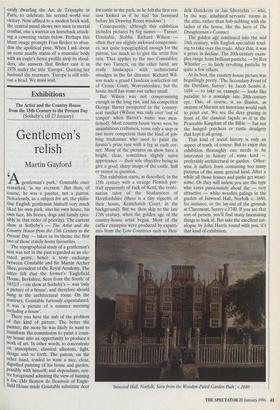Exhibitions
The Artist and the Country House from the 15th Century to the Present Day (Sotheby's, till 27 January)
Gentlemen's relish
Martin Gayford gentleman's park,' Constable once remarked, 'is my aversion.' But then, of course, he was a painter, not a patron. Notoriously, as a subject for art, the philis- tine English gentleman himself very much liked his own park, also his own house, his own face, his horses, dogs and family (pos- sibly in that order of priority). The current show at Sotheby's — The Artist and the Country House from the 15th Century to the Present Day — takes as its theme the first two of those stately home favourites.
The topographical study of a gentleman's seat was not in the past regarded as an ele- vated genre, hence a testy exchange between Constable and Sir Martin Archer Shee, president of the Royal Academy. The latter felt that the former's 'Englefield House, Berkshire, Seen from the South' of 1832/3 — on show at Sotheby's — was 'only a picture of a house', and therefore should hang in the architectural room. On the contrary, Constable furiously expostulated, it was 'a picture of a summer morning Including a house'.
There you have the nub of the problem of this kind of picture. The better the Painter, the more he was likely to want to transform the commission to paint a coun- try house into an opportunity to produce a work of art. In other words, to concentrate on atmosphere, classical allusions, light, design and so forth. The patron, on the other hand, tended to want a nice, clear, dignified painting of his house and garden, possibly with, himself, and dependants, cen- tre foreground admiring the view of hunting a fox. (Mr Benyon de Beauvoir of Engle- field House made Constable substitute deer for cattle in the park, as he felt the first ver- sion looked as if he had 'his farmyard before his Drawing Room windows'.) Consequently, although this exhibition includes pictures by big names — Turner, Constable, Stubbs, Richard Wilson often they are slightly awkward compromis- es, not quite topographical enough for the patron, too much so to give the artist free rein. That applies to the two Constables; the two Turners, on the other hand, are really landscapes with architectural smudges in the far distance. Richard Wil- son made a grand Claudean confection out of Crome Court, Worcestershire, but the house itself has come out rather small.
But Wilson was not compromising enough in the long run, and his competitor George Barret prospered in the country- seat market (Wilson was only ever 'out of temper' when Barret's name was men- tioned). Most country-house views were by unambitious craftsmen, some only a step or two more competent than the kind of job- bing tradesman who used to paint the farmer's prize ram with a leg at each cor- ner. Many of the pictures on show have a bright, clear, sometimes slightly naive appearance — their sole objective being to give a good, sharp image of the castle, hall or manor in question.
The exhibition starts, as described, in the 15th century with a strange Flemish por- trait apparently of Jack of Kent, the cente- narian tutor of the Scudamores of Herefordshire (there is a tiny vignette of their house, Kentchurch Court, in the background). But we then skip to the late 17th century, when the golden age of the country-house artist began. Most of the earlier examples were produced by expatri- ates from the Low Countries such as Hen- drik Danckerts or Jan Siberechts — who, by the way, inhabited servants' rooms in the attic, rather than hob-nobbing with the ladies of the house, like the hero of The Draughtsman's Contract.
The golden age continued into the mid 18th century, with English specialists tend- ing to take over the trade. After that, it was a genre in decline. The 20th-century exam- ples range from brilliant pastiche — by Rex Whistler — to fairly revolting pastiche by quite a few others.
At its best, the country-house picture was beguilingly pretty. 'The Secondary Front of the Durdans, Surrey', by Jacob Scmits d. 1694 — to take an example — looks like paradise to a nostalgic late 20th-century eye. This, of course, is an illusion, as swarms of Marxist art historians would rush to point out. We see the deer grazing in front of the classical façade as if in the Peaceable Kingdom of the Bible — but not the hanged poachers or rustic drudgery that kept it all going.
That kind of social history is only an aspect of truth, of course. But to enjoy this exhibition thoroughly one needs to be interested in history of some kind preferably architectural or garden. Other- wise it suffers from containing too many pictures of the same general kind. After a while all those houses and parks get weari- some. Or they will unless you are the type who cares passionately about the — very attractive — white wooden palings in the garden of Intwood Hall, Norfolk c. 1680, for instance, or the lay-out of the grounds at Claremont, Surrey c.1740. If you are that sort of person, you'll find many fascinating things to look at. But take the excellent cat- alogue by John Harris round with you, it's that kind of exhibition.
Intwood Hall, Norfolk, Seen from the Wooden-Paled Garden Path, c.1680


























































 Previous page
Previous page